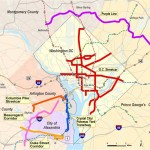Metro Studying Opportunities for Coordination of Regional LRT and Streetcar Systems

This map shows the corridors being studied by the region for potential light rail, streetcar, or bus rapid transit lines. Click the image for a larger version.
The Washington, DC metropolitan region may be the home of a light rail line and several streetcar lines in the near future according to regional plans. The state of Maryland is in the preliminary engineering phase of the Purple Line, a 16-mile light rail line that is proposed to run between Bethesda in Montgomery County to New Carrollton in Prince George’s County. The District of Columbia has almost completed construction of the H Street-Benning Road streetcar line, with scheduled revenue operation expected to begin later this year, and has also planned an expanded streetcar network. Meanwhile, Arlington and Fairfax Counties have submitted an application for federal Small Starts funding to begin project development for the Columbia Pike Streetcar line, running almost five miles from Pentagon City in Arlington to Bailey’s Crossroads in Fairfax County. Arlington County is also advancing planning for its Crystal City Streetcar project, which would run from Pentagon City, through Crystal City, to the southern Arlington County line in Potomac Yard. (The Crystal City Streetcar project can be considered a follow-up to the Crystal City Transitway project currently under construction.)
Recognizing that Metro isn’t the sponsor or funding agent for these LRT and streetcar systems, and that key decisions made early in the process on the Columbia Pike and H Street streetcar lines have the potential to affect other systems for years to come, Metro has been coordinating with the sponsors since 2010 through the LRT and Streetcar Interoperability Study. A briefing on this study was presented to the Metro Board in early 2011.
Specifically, we are aiming to promote customer convenience, cost efficiency, and regional transit network coherence by maximizing the degree to which these diverse projects around the region can adopt compatible power, control, track, fare, and passenger information systems and – to the extent possible – make physical connections with one another. To the extent that vehicle technologies can be conformed and storage and maintenance facilities consolidated, these also are being explored.
Metro has been convening quarterly work group meetings with technical staff of the project sponsors. The group has focused on the compatibility of systems and infrastructure in the following areas:
- Vehicles
- Operations and Maintenance Facilities
- Power Supply
- Guideway Design
- Fare Collection System
- Passenger Information and User Interface
The study team’s recommendations so far have been documented in a technical memorandum, posted on Metro’s website, and summarized in this presentation: LRT-Streetcar Project Interface Feb 2013.
The study team is continuing to meet with the regional project teams and is planning to go back to the Metro Board of Directors to bring the issue up for discussion again in early 2013.


Thank you all for doing this. Lack of regional integration is my main fear for these developing regional transportation plans. We can’t dig ourself a hole upfront when we spend so much on implementing new infrastructure, fare payment systems, and design elements. Standardization would be very nice and advantageous for this region.
I hope this study process yields some beneficial results.